Crown hair transplant: growth time and results
By Prof. Dr. Soner Tatlidede 2019-07-09
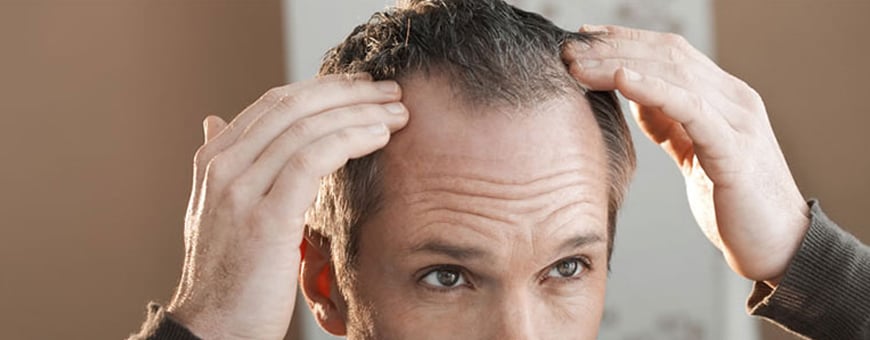
A crown hair transplant is intended to correct baldness problems in the crown area, which is located in the posterior part of the scalp, specifically where the scalp starts to slop downward. The crown ends where the occipital bone begins (usually, in hair transplant we take hair grafts from this occipital scalp, especially when we are using the FUT method). Sometimes we mention to this area by calling it “vertex”, which is the highest point of the head.
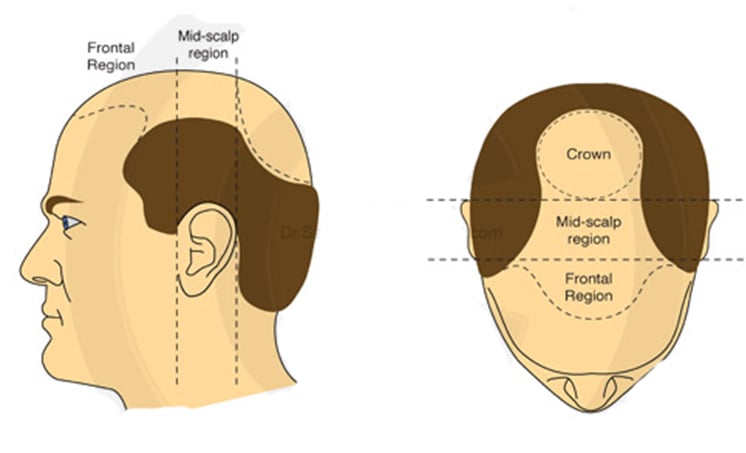
Blood circulation in the crown area
The picture below shows us the scalp arteries network. These arteries branch out to smaller arteries, and then branch again to form blood capillaries (not shown in this picture). These blood capillaries are responsible for supplying the follicles with blood and nutrients that the hair needs for the growth process. Evidently, the blood pressure and the flow rate will be much higher inside the bigger blood vessels in compare with the small blood capillaries.
As we can notice, these large blood vessels are located next to the follicles that exist in the laterals of the head, but further way from the follicles that we find in the vertex. As a result, we will find that the blood pressure and flow rate inside blood capillaries that are located at the sides of the head will be a little higher than in the blood capillaries that are located in the vertex area.
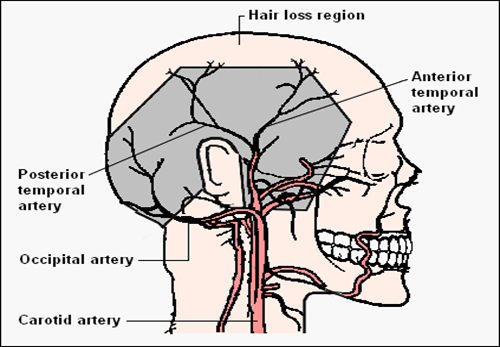
Hair characteristics in the crown area (the whorl)
A whorl is a point located in the crown area, where the hair grows in a circular pattern, either clockwise or counter clockwise. The shape of this whorl is somehow responsible for how we should make a hair transplant in the crown area. In some cases, we may have more than one whorl, and this will increase the difficulties that we face during a hair transplant surgery.
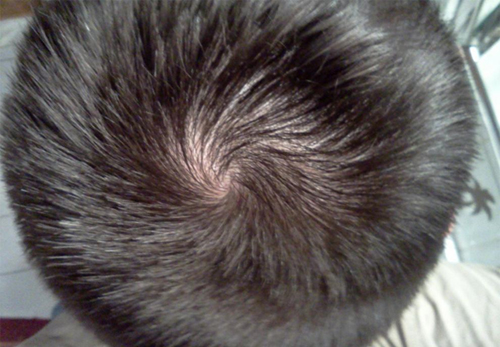
How does the vertex baldness evolve?
Vertex balding is a part of general baldness. This baldness appears after it occurred in the frontal or middle area of the scalp. The importance of hair falling in vertex area differs depending on the patient´s age, and it becomes effective in stages III vertex, IV, V VI and VII of the Norwood scale.
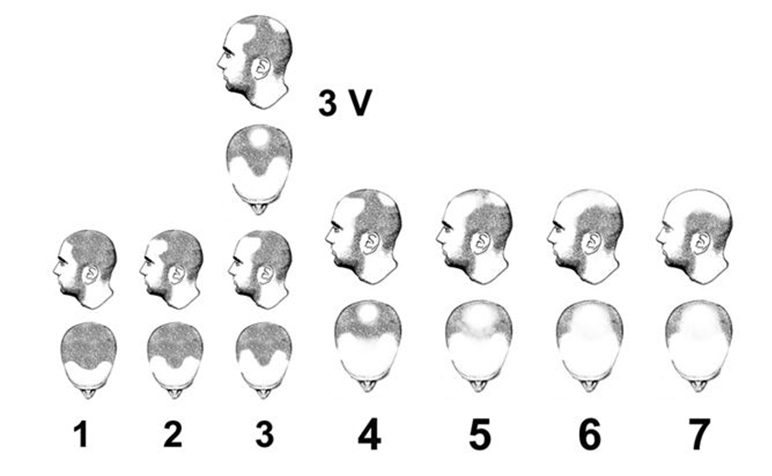
According to the Norwood study:
- Between 18 and 29 years old, only 6% of male pattern baldness is related to the vertex.
- Between 30 and 39 years old, 21%
- Between 40 and 49 years old, 30 %
- Between 50 and 59 years old, 37 %
- Between 60 and 69 years old, 53%
- Between 70 and 79 years old, 50 %.
Sometimes hair falling happens essentially in the vertex: it starts from the center of the vertex and then spreads to the surrounded area. Later, it develops and takes a circular shape and gradually grows to the exterior area. The circular surface dramatically develops while the diameter of the circle is growing.
As a result, we should pay attention when we are judging an incomplete hair falling. Hair will keep falling in this area until we have a circle empty of hair with a diameter of about 10 cm.
Crown area hair transplant: what results can I expect?
A hair transplant in this area represents one of the most technically challenging areas for many reasons. The cost of a crown hair transplant in a clinic at Istanbul, Turkey, varies between 600 and 2,000 euros depending on each case. These are the main difficulties of this type of surgery:
- First: the existence of a whorl point makes the hair grow from different angles, so the hair pattern in the crown area should be recreated in order to ensure that the angle of the transplanted hair matches the angle of the natural hair.
- Second: the hair must be tightly interlocked to achieve the greatest amount of hair density, especially in the upper arc of the hair, where hair overlaps with the rest of the hair in the crown. A judicious graft choosing and placement will get the best result for a hair transplant in this area.
- Third: the donor area has a limited number of follicles. On the other hand, the area of the crown is big and it needs around 6,500 grafts in order to cover it completely; this number is much bigger than the number that exists in the donor area. This large number means that there will be no chance to restore the frontal line or the front area of the head in case of hair loss.
Because of these three previous reasons, before starting any procedure for a crown transplant we have first to discuss the following points between patient and doctor.
Do you have hair loss in other regions of the scalp?
In spite of considering the crown area important for many patients, it is generally a less "cosmetically significant" compare to the frontal line and the front scalp. Fortunately, the crown is located in the upper part of the scalp near the end of the head, so most of the people cannot see it, whereas the frontal line is seen by everyone.
As a result, if you are experiencing hair loss in the frontal line you should first treat this region and then start with the crown area.
How much donor area do you have available for the transplant surgery?
The donor area is limited and if the patient is suffering from heavy hair loss, that means that the patient may not have enough grafts to cover the whole scalp.
If you are planning to do a crown transplant and you have a limited donor area, you have to ask yourself this question: "How I will look if I use all the grafts that I have in my donor area in order to do a crown transplant, and then I start to suffer from hair falling in the frontal part of the scalp?". The answer will be, of course, “my hair will not look natural".
Having a lot of hair in the crown area and suffering from hair absence in the frontal part of the scalp will give us an abnormal and uncommon look. On the other hand, we can see that men have a heavy front line but suffer from some gaps in the crown area, and this situation is considered normal and we see it a lot. For this reason, if you have a limited donor area and you can only transplant one region in the scalp, we advise you to focus on the frontal line.
If the patient has a full hair density in the frontal area with gaps in the crown area of scalp, here we can evaluate the donor area in a different way. However, it is difficult to predict how a patient's hair loss will progress and it is always wise to be sure that we have enough reserve grafts in the donor area for the front part.
How old are you?
When we have young patients we should be more accuracy while we are evaluating their situation before take any decision about a crown transplant. Although a "bald spot" can be psychologically tough for a young man, patients who suffer from thinning in this area may have more hair falling.
If we use all the grafts in the donor area and then the hair starts to fall in other parts of the head, the patient will find himself with a heavy hair in crown area and baldness around the crown.
Depending on what we have mentioned earlier, we therefore conclude the following:
- When we have patients suffering from continuous hair loss and they have a limit number of grafts, we should deal with these grafts wisely.
- If the hair starts to fall in the crown area, it is possible that it will also start to fall in the frontal area. Therefore, we prefer to use the grafts for the frontal area and wait to see what will happen with the frontal area after the transplant surgery.
Crown hair transplant timeline
At Clinicana we use the FUE technique for a crown hair transplant at our clinic, as this is the most modern method and allows a full recovery in a very short period of time, with no scars and rarely any side effect. Depending on each case and patient, the full operation takes between 4 to 6 hours, and then you can go back your home/hotel and take a rest.
During the first two weeks after the surgery, you may experience some redness in the donor and the operated areas, and you may also suffer from some hair loss, but this is absolutely normal and you don´t have to worry. From two weeks after the operation you can use scissors to (carefully) cut your new implanted hair, but do not use shaving machine until the fifth month.
Between 2-4 months after the transplant, new hair from the transplanted follicles should start coming out; and after 5-9 months –depending on the patient- you should see a considerable amount of hair emerging from the crown. Finally, after about 12 months (1 year) most of the hairs implanted in your crown will have emerged from the scalp.
In summary, a crown hair transplant is a step with some risks because the crown is a "moving target" that evolves as times goes by. Patients should ask the doctor before take any decision in order to take the right steps and get the best results: something we can provide you at our clinic in Istanbul.









